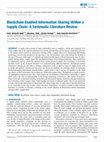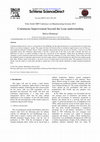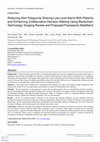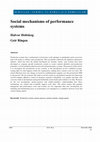Papers by Halvor Holtskog

IEEE Access, 2020
A supply chain consists of many stakeholders such as suppliers, carriers and customers. It is oft... more A supply chain consists of many stakeholders such as suppliers, carriers and customers. It is often complex due to the rapid development of economic globalization and the intense competition pressure in the market which resulted in information sharing within a supply chain to be fragmented. Blockchain technology can solve this problem by having only a ''one trusted ledger'' that could reshape the element of data trust. The goal of this paper is to identify and understand the impact of blockchain technology for information sharing within a supply chain. The decentralized nature of blockchain technology offers a high level of transparency and has gained the attention from various sectors to deploy this technology. A systematic literature review in the academic literature was conducted using different databases. Blockchain-enabled information sharing can add value to enhance collaborative work in different types of supply chains such as health and medical, construction and smart city. From our findings, one potential impact of deploying blockchain-enabled information sharing within a supply chain is that it ensures all members in the chain can obtain verified information which enhances collaborative partnerships. Through this in-depth research, we highlighted potential barriers that could impede the development of blockchain technology in supply chain such as the lack of understanding of blockchain technology in businesses and conflict of interests. Future work such as information hiding, in parallel with information sharing, could close the gap in deploying this technology within a supply chain. Understanding the nature of different supply chain is also important to better prepare the deployment of blockchain. We acknowledge that our approach in selecting literatures in our systematic review may exclude certain literatures. Nonetheless, we tried to include as many relevant literatures as possible, to develop a roadmap on the current situation of blockchain-enabled information sharing within a supply chain. INDEX TERMS Blockchain, smart contract, supply chain management, information sharing.

Procedia CIRP, 2013
Continuous Improvement is seen as a cornerstone in Lean Thinking, but the improvement process of ... more Continuous Improvement is seen as a cornerstone in Lean Thinking, but the improvement process of operations has been done long before Lean entered companies' agenda. This paper will draw the historical line of continuous improvement in one of Norway's most important automotive industry clusters, where continuous improvement has been an issue over decades. A survey of over 600 respondents shows that continuous improvement is felt like a natural part of the tasks in the daily work-life. But there are differences of what is so natural according to what role a person has in the companies. Similar there are differences between companies in what continuous improvement actually is done when the companies are in the same industry. These results show that the simplified notion of continuous improvement is far from simple and has a cultural foundation in which the Lean tradition speaks little about. Workers union involvement is crucial for success of improvements at the factory floor. This argument will have the Nordic work-life model as a back-drop and help to explain how to deal with cultural foundation in highly automated production lines.
Springer eBooks, 2019
Lean management remains the most popular approach to operational excellence within industry. The ... more Lean management remains the most popular approach to operational excellence within industry. The next wave of industrial improvement is widely considered to be driven by the application of digital technologies. Organizations are seeking to understand how the two approaches can be utilized synergistically. This paper aims to sketch the landscape for current theories and managerial challenges facing Lean and digital transformation based on Lean principles with respect to organizational design, supply chain planning, decision systems and supplier relationships. We raise fundamental questions that should be addressed by future research in the field of digital lean manufacturing and lean digital transformations.

International Journal of Computer Integrated Manufacturing, Dec 1, 2013
This paper discusses how intrinsic motivation is affected by lean enablers such as clear project ... more This paper discusses how intrinsic motivation is affected by lean enablers such as clear project objectives and Customer Requirements (CR), continuous improvement and cross-functional teams. It is assumed that – if you know what the customer wants, are able to collect a broad variety of ideas and define potential risks as early as possible, and finally continuously work to solve all problems along the way – you probably work according to a lean product development approach. Nevertheless, how does this picture fit into motivation theory and engineer critical psychological states? To investigate this question, a survey was undertaken among Norwegian automotive suppliers. The results show that only the variable CR are significantly related to motivation. Accomplishing CR is seen as the primary activity by product developers and believed to be in closer proximity toan engineer than the other variables.

Procedia CIRP, 2020
Abstract Little attention in the Lean literature has focused on disruptive events and change. How... more Abstract Little attention in the Lean literature has focused on disruptive events and change. However, there is emerging an awareness of the insufficiencies built into this line of thinking and the way it is conducted in practice. The purpose of this paper is to highlight how underdeveloped Lean thinking is to meet disruptive events or Kodak moments. This case study illustrates how strong commitment to Lean thinking not necessarily helps in critical situations. Following a path turning lean from the initiative top-down to a bottom-up approach, including softer components as knowledge, reflection, culture and involvement. While compensated the situation to some extent, but in general, the lean tool-box was insufficient to align the organization to change. Missing in the change initiative was time for reflection and discussion about what to reflect upon, central part of Hensai. The paper gives insights into how a company with traditional Lean implementation struggles with aligning change with market development. The solar panel industry serve as case study. 17 in-depth interviews have been conducted with people directly involved in the cases.
This chapter scrutinizes the micro level of the industrial production processes, that is, the lev... more This chapter scrutinizes the micro level of the industrial production processes, that is, the level of firm. It shows how global manufacturing/managerial trends, sectoral specific factors, national contexts, and firm specific features are represented into firms’ observable cultural aspects and artifacts. The analysis provides the deeper understanding of subcultures and their respective behaviors, as well as, functions in a manufacturing context.
This chapter broadens and deepens insight from the previous chapter by bringing in another theore... more This chapter broadens and deepens insight from the previous chapter by bringing in another theoretical perspective: the Geertzian perspective of culture. It describes how the import of broader global managerial trends affect knowledge-creation processes and the differentiated cultures they are embedded in.
Procedia CIRP, 2012
This paper examines the innovation process in four Norwegian companies, all supplying the automot... more This paper examines the innovation process in four Norwegian companies, all supplying the automotive industry with light weight structural components. Twelve representative product projects are categorized, together with people from product development in respective companies, according to product and process novelty. The main contribution from this study is twofold; first, a new framework and index for categorizing innovation across product and process newness is developed, second, putting empirical data into the framework demonstrates that product and process uniqueness does not seem to be dependent on amount of resources.

Journal of Medical Internet Research, Oct 28, 2020
Background: Clinical decision support (CDS) is a tool that helps clinicians in decision making by... more Background: Clinical decision support (CDS) is a tool that helps clinicians in decision making by generating clinical alerts to supplement their previous knowledge and experience. However, CDS generates a high volume of irrelevant alerts, resulting in alert fatigue among clinicians. Alert fatigue is the mental state of alerts consuming too much time and mental energy, which often results in relevant alerts being overridden unjustifiably, along with clinically irrelevant ones. Consequently, clinicians become less responsive to important alerts, which opens the door to medication errors. Objective: This study aims to explore how a blockchain-based solution can reduce alert fatigue through collaborative alert sharing in the health sector, thus improving overall health care quality for both patients and clinicians. Methods: We have designed a 4-step approach to answer this research question. First, we identified five potential challenges based on the published literature through a scoping review. Second, a framework is designed to reduce alert fatigue by addressing the identified challenges with different digital components. Third, an evaluation is made by comparing MedAlert with other proposed solutions. Finally, the limitations and future work are also discussed. Results: Of the 341 academic papers collected, 8 were selected and analyzed. MedAlert securely distributes low-level (nonlife-threatening) clinical alerts to patients, enabling a collaborative clinical decision. Among the solutions in our framework, Hyperledger (private permissioned blockchain) and BankID (federated digital identity management) have been selected to overcome challenges such as data integrity, user identity, and privacy issues. Conclusions: MedAlert can reduce alert fatigue by attracting the attention of patients and clinicians, instead of solely reducing the total number of alerts. MedAlert offers other advantages, such as ensuring a higher degree of patient privacy and faster transaction times compared with other frameworks. This framework may not be suitable for elderly patients who are not technology savvy or in-patients. Future work in validating this framework based on real health care scenarios is needed to provide the performance evaluations of MedAlert and thus gain support for the better development of this idea.
From a macro and national perspective, this chapter focuses on the specificities of a manufacturi... more From a macro and national perspective, this chapter focuses on the specificities of a manufacturing sector, that is, the Norwegian automotive industry. The chapter introduces the reader to product development in the industry, demonstrating how the organization learns (or not) from the one product development project to the next. This descriptive approach as to how product development occurs in real settings is in stark contrast to the one presented in the firms’ formal description of quality management systems and other types of formal displays. This chapter provides therefore, a unique insight in a) the discrepancies between firms’ fragmented and not always coinciding representations of realities of real production processes and b) the challenges firms’ meet in accumulating knowledge and know-how between projects.
Procedia CIRP, 2016
This paper discusses improvements of an existing manual assembly line for roller skis when it was... more This paper discusses improvements of an existing manual assembly line for roller skis when it was used as a template for a learning factory in the university. These improvements were in terms of lean philosophy and operations management, angled towards the application of "flexibility" and "learning factories" concepts. The article introduces list of suggestions that were built up with the help of several techniques presented in the paper. These techniques can bring significant improvements if wisely applied. A novel contribution of this article is combination of theoretical knowledge with application of it to the real life case used to make necessary enhancements to increase production capacity of the assembly line and involve it into the learning factory.
Springer eBooks, Oct 12, 2017

European journal of workplace innovation, Dec 10, 2018
Production systems have continuously evolved since early attempts to standardise parts, processes... more Production systems have continuously evolved since early attempts to standardise parts, processes and work modes to enhance mass production. This was further refined by the Japanese automotive industry, which has been the global benchmark for decades. Lately, such systems have been developed as company specific production systems to create common identities and production principles, to form global production networks and performance systems. The purpose of this article is to investigate the introduction of new systems, or the introduction of new combined systems, casting light on what happens inside the organisation, making these systems work over time. The article illustrates how true change occurred in a multinational company over the period from 2000 to the present. The key point for this study is not the system as a formalised structure for improving overall company efficiency, based on measures regards to flexibility, cost, quality and time. Our concerns relate to mechanisms and agents behind the system itself, and evolution over time. We focus on the two mechanisms, mentor-sponsor and insider-outsiders, understanding how these mechanisms are related and eventually support each other. The article argues that popular managerial and performance tools and systems are less important than how mechanisms for initiating and maintaining focus on performance are managed as a symbiosis between local and central change agents.
This chapter reflects upon the body of accumulated knowledge gathered in the previous chapters by... more This chapter reflects upon the body of accumulated knowledge gathered in the previous chapters by identifying the key skills and sensitivities that good management teams within modern manufacturing companies should possess. Given the complexities and variability of modern manufacturing production lines and markets, the management teams must ensure they act in a facilitative manner, that is, to be able to intelligently tap into and act upon cultural understanding to unleash the creative forces and eagerness of learning embedded in the organization. Are these insights adequately embedded in modern industrial policies?

Springer eBooks, 2018
The central theme of this series is to explore why some areas grow and others stagnate, and to me... more The central theme of this series is to explore why some areas grow and others stagnate, and to measure the effects and implications in a trans-disciplinary context that takes both historical evolution and geographical location into account. In other words, when, how and why does the nature and dynamics of a political regime inform and shape the drivers of growth and especially innovation and entrepreneurship? In this socioeconomic and socio-technical context, how could we best achieve growth, financially and environmentally? This series aims to address such issues as: • How does technological advance occur, and what are the strategic processes and institutions involved? • How are new businesses created? To what extent is intellectual property protected? • Which cultural characteristics serve to promote or impede innovation? In what ways is wealth distributed or concentrated? These are among the key questions framing policy and strategic decision-making at firm, industry, national, and regional levels. A primary feature of the series is to consider the dynamics of innovation and entrepreneurship in the context of globalization, with particular respect to emerging markets, such as China, India, Russia, and Latin America. (For example, what are the implications of China's rapid transition from providing low-cost manufacturing and services to becoming an innovation powerhouse? How do the perspectives of history and geography explain this phenomenon?) Contributions from researchers in a wide variety of fields will connect and relate the relationships and inter-dependencies among (1) Innovation, (2) Political Regime, and (3) Economic and Social Development. We will consider whether innovation is demonstrated differently across sectors (e.g., health, education, technology) and disciplines (e.g., social sciences, physical sciences), with an emphasis on discovering emerging patterns, factors, triggers, catalysts, and accelerators to innovation, and their impact on future research, practice, and policy. This series will delve into what are the sustainable and sufficient growth mechanisms for the foreseeable future for developed, knowledge-based economies and societies (such as the EU and the US) in the context of multiple, concurrent and interconnected "tipping-point" effects with short (MENA) as well as long (China, India) term effects from a geo-strategic, geo-economic, geo-political and geo-technological set of perspectives. This conceptualization lies at the heart of the series, and offers to explore the correlation between democracy, innovation and growth.

Procedia CIRP, 2013
This study reveals the history of a Norwegian automotive supplier that went bankruptcy during the... more This study reveals the history of a Norwegian automotive supplier that went bankruptcy during the financial crisis in 2009. The crisis swept through the industry and hit hard for those actors who already struggled to keep up with the cost pressure. A few people kept faith in knowledgeable workers and innovative ideas, and the company arose from the cumbersome situation to become a sole supplier of critical wheel suspension systems to European premium brands. The company managed to ascend and invest in R&D and innovations that save weight, reduce number of components and save cost. The main research question asked in this study is what strategic capabilities are demonstrated when turning a crisis into opportunities. The study shows interesting features about how a supplier can adapt to a completely new market situation by focusing on, and combining, R&D, customer relations, cocreation, employee competency, sustainability and ability to adapt. The essence is that the crisis was not entirely negative-it also gave opportunities for those who dared to invest in human capital, technology and niche markets.

Journal of The Knowledge Economy, Oct 10, 2015
The dualism of science, technology and innovation (STI) and doing, using and interacting (DUI) mo... more The dualism of science, technology and innovation (STI) and doing, using and interacting (DUI) modes of innovation has been accepted by scholars as a seemingly clear and useful heuristic dichotomy for analysing and benchmarking innovation systems. This paper challenges the existence of this dichotomy. Rather than the traditional approach of looking at statistical data and financial statements figures, our empirical findings are based on a thorough field analysis of product development projects in the Norwegian automotive industry. We argue that in the process of embedding scientific knowledge into products, the companies apply interchangeably STI mode and DUI mode in a sophisticated pattern of knowledge creation. Unawareness of these subtle integrating processes can lead to wrong conclusions about how knowledge is actually generated and processed at the ground floor in manufacturing firms. Misguided policy interventions can, in the worst case, be the result of such wrong conclusions.We followed firms in automotive industry in various product development projects. In addition to an understanding of product development processes, we investigated how the knowledge is created and implemented into specific products. The objective of the paper is to provide with more accurate understanding of how knowledge processes shape competitive advantages at the firm level.

Uploads
Papers by Halvor Holtskog